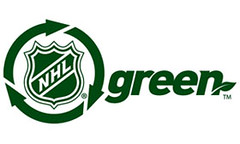The National Hockey League is the only major sports league with all of its teams participating in stadium food recovery. Bernadette Mansur, the NHL’s senior VP of public affairs, helped launch the NHL Green Initiative in 2010. To find out how the Green initiative came to include its league-wide food recovery program, I spoke with Mansur:
Wasted Food: How did the NHL food recovery program come to exist?
Bernadette Mansur: The fellow who heads Rock and Wrap It Up, the food recovery program, Syd Mandelbaum, has been recovering food from arenas with different sports and clubs. He came in through a recommendation to one of the executives in the league. Because it was food donation and something that would be in the community, it was referred to me.

So I brought Syd in to meet [commissioner] Gary [Bettman] and the same thing happened. To get untouched but prepared food to homeless shelters was simply the right thing to do. And the way they do it is failsafe. They vet the shelters to make sure they have all their bases covered.
Gary then presented the idea to the owners at the June 2010 board meeting. And at that meeting, he gave the presentation and said let’s vote. It took about 20 seconds before everyone in the room raised their hands. It was a very simple decision to make. And then we found that nine of our clubs were already doing it!
How does the food recovery work, in practice?
The Concessionaires have these big carts and they go from stand to stand and pick up the unsold, untouched foods. They bring it to the loading platforms at the stadia. The shelter is responsible for picking up the food. That alleviates the issue of having the club or concessionaires drive it to the shelters. One of the questions that came up in the board meeting was on the Good Samaritan Act passed in the Clinton Administration. This US law was adopted in all the provinces in Canada. But the concessionaires were satisfied with the law and really love participating in the program.
What kinds of foods are/are not donated?
The food that is donated is concession food that has been prepared but not sold. And the majority of concessions have backup food–you never know when there will be an overtime. That also is donated. Some stadiums donate food served in the suites and some don’t.
Do the players get involved in any way?
They do get involved. Most of the players are playing when the pickup happens. But if a player isn’t playing that night, they may say ‘I want to pack the food up or give it to the people from the shelter.’ The players and the club employees really do feel good about it.
Have there been any obstacles to getting food donation established?
Some of the food service people took some convincing. They thought we were going to be donating raw foods. But in the end, everybody knows how worthwhile it is. And when they saw the people from the shelter pick it up, and they were so thankful–that goes a long way.
Do you have any league-wide stats for the amount of food rescued and what are the future goals for the program?
Through our clubs, we developed a data program where each of the clubs can have their food service provider put in how much they donated. At the end of this season, as a league, we’re going to have donated more than 100 tons of food to people who need it. Another way of saying that is that we’ve kept 100 tons of food out of the landfill.